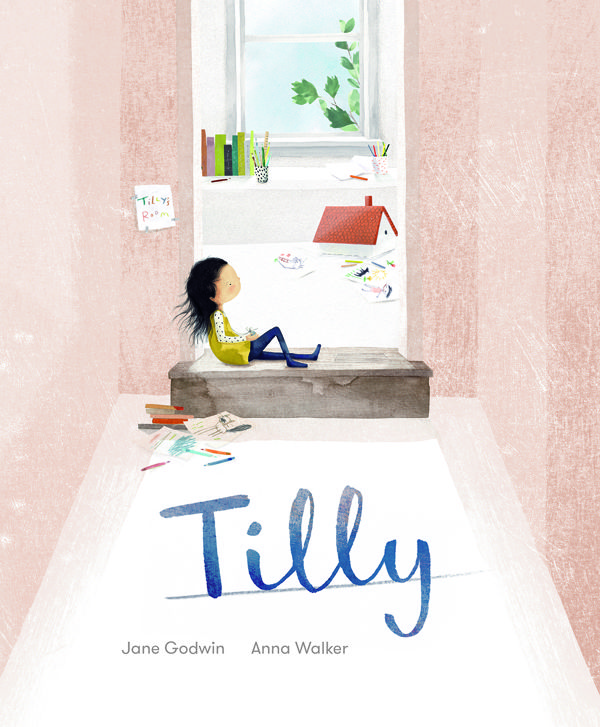Tilly

Illustrator: Anna Walker
Author: Jane Godwin
Publisher: Scholastic Australia
ISBN: 9781760663728
The publisher says...
Tilly has found the perfect hiding place to keep her special treasures. No one knows about it, not even her big brothers and sister, who know everything. But one day, something happens that Tilly could never have imagined...
The author says...
Tilly is based on true events. I grew up with three siblings. The youngest, Cait, had a bedroom that was a converted attic up in the roof of our old house. There was a wooden step up to Cait’s bedroom, which we all assumed was fixed to the wall and floor. Only six-year-old Cait knew that the step was freestanding and movable. She used to hide all her special treasures in the step, and none of us ever knew about it.
Then, just like in the story, one day we had the house re-carpeted, and carpet was laid over the step so that there was no access to it. Cait’s treasures were trapped!
She never told anyone about this until about eight years ago when she was in her early forties! We have visited that house in the last few years when it was open for inspection, and the same carpet is still over the step. Cait’s treasures are still there, all these years later.
Thinking about kids today, it may be surprising to them that Cait didn’t tell anyone, or seek help from our parents etc. But in the 1970s, when the story is set, this seemed perfectly normal. We didn’t expect to share everything with our parents then, and we didn’t expect that our parents would solve all our problems! I have asked Cait why she didn’t tell anyone, and it was partly because she felt embarrassed. I also believe it was something about not wanting to share her secret world, her inner life, even when it was being threatened. It was easier for children to have an inner life back then – when people had ramshackle houses and overgrown back gardens that you could lose yourself in, when children weren’t photographed and videoed every day of their lives, when parents weren’t hovering over them so much. I think it’s important for children to be able to have secrets, in fact I think it’s the beginning of creativity. I think that’s why the story resonated with me when Cait told us about it all these years later when we were all middle-aged adults. That there’s something in her actions about the importance and sacred nature of one’s inner life. And of maintaining the integrity of that.
I wrote many different endings for the story, some of which Tilly was able to retrieve the treasures. But in the end I thought I would remain faithful to the real events, and I’m glad I did.
I love the way Anna has illustrated the story. My favourite pic is probably the night time picture where Tilly is at her window. I think Anna has captured so perfectly that feeling one has when one is a child of the world being so big and so hard to understand and make sense of, but also that it’s somehow beautiful and magical.
When you’re a writer, there are lots of anecdotes and memories and observations that you think that could be the beginning of a story. The ones that stick are those that say more than what they appear to say on the surface, that resonate in some way. When Cait told me about the step, I thought while being a story about a little girl who lost her special things, it was also a story about grief, about loss, about the way we can hold on to and embody what is special to us long after it’s gone. And it felt to me that is was also a story about a child’s inner life, an aspect of themselves that they didn’t want to share, the beginning of a creative life maybe, and how every child has a right to an inner life.
From the author's website.
Anna and Jane talk about 'Tilly'
Click on the icon below for a video of Jane Godwin and Anna Walker talking about Tilly.
The CBCA judges say...
Exquisite illustrations accompany a beautiful, unusual and intriguing story that captures a small girl's identity through her relationship with treasured objects in a noisy home. Tilly, the youngest and quietest in a family of active boys and one other sister, finds her own space and her own pastimes which give her pleasure and security. These objects are hidden beneath the stair into her room and, ultimately, become lost to her forever when the house is carpeted. The language is simple yet evocative, delving into the world of the protagonist. The linework is delicate and captures the overall feeling of quietness and subtle appreciation of the world in which the child lives. Colours are muted but the clutter and movement in the house is captured in scattered objects rather than bright colours. The print text is smaller than usual and gathered tightly in open-ended space which, again, is reflective of the nature of the story. This is a book that would be enjoyed over and over again and each time something new would be found or pondered. The production, text and illustrations are of the highest level.
Our Reading Time reviewers say...
Click here to read the Reading Time review
Teaching Notes for the book…
Pegi Williams Bookshop has generously made teaching resources available for this book. Click on the icon below to view these resources.
